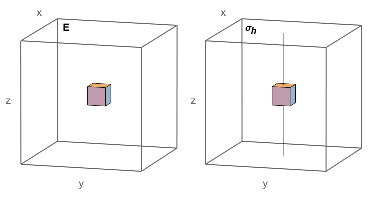+Table of Contents
This is an old revision of the document!
Orientation Z
Symmetry Operations
In the Cs Point Group, with orientation Z there are the following symmetry operations
| Operator | Orientation |
|---|---|
| E | {0,0,0} , |
| σh | {0,0,1} , |
Different Settings
Character Table
| E(1) | σh(1) | |
|---|---|---|
| A' | 1 | 1 |
| A'' | 1 | −1 |
Product Table
| A' | A'' | |
|---|---|---|
| A' | A' | A'' |
| A'' | A'' | A' |
Sub Groups with compatible settings
Super Groups with compatible settings
Invariant Potential expanded on renormalized spherical Harmonics
Any potential (function) can be written in spherical coordinates as a sum over spherical harmonics V(→r)=∞∑k=0k∑m=−kAk,m(r)C(m)k(θ,ϕ). With C(m)k(θ,ϕ) a renormalised spherical harmonics C(m)k(θ,ϕ)=√4π2k+1Y(m)k(θ,ϕ). The allowed expansion coefficients Ak,m(r), or once evaluated for a given radial wave-function Ak,m=⟨ψ(r)|Ak,m(r)|ψ(r)⟩, such that $V(\vec{r}) is invariant under all symmetry operations of the Cs Point group with orientation Z are:
Input format suitable for Mathematica (Quanty.nb)
Ak,m={A(0,0)k=0∧m=0−A(1,1)+iAp(1,1)k=1∧m=−1A(1,1)+iAp(1,1)k=1∧m=1A(2,2)−iAp(2,2)k=2∧m=−2A(2,0)k=2∧m=0A(2,2)+iAp(2,2)k=2∧m=2−A(3,3)+iAp(3,3)k=3∧m=−3−A(3,1)+iAp(3,1)k=3∧m=−1A(3,1)+iAp(3,1)k=3∧m=1A(3,3)+iAp(3,3)k=3∧m=3A(4,4)−iAp(4,4)k=4∧m=−4A(4,2)−iAp(4,2)k=4∧m=−2A(4,0)k=4∧m=0A(4,2)+iAp(4,2)k=4∧m=2A(4,4)+iAp(4,4)k=4∧m=4−A(5,5)+iAp(5,5)k=5∧m=−5−A(5,3)+iAp(5,3)k=5∧m=−3−A(5,1)+iAp(5,1)k=5∧m=−1A(5,1)+iAp(5,1)k=5∧m=1A(5,3)+iAp(5,3)k=5∧m=3A(5,5)+iAp(5,5)k=5∧m=5A(6,6)−iAp(6,6)k=6∧m=−6A(6,4)−iAp(6,4)k=6∧m=−4A(6,2)−iAp(6,2)k=6∧m=−2A(6,0)k=6∧m=0A(6,2)+iAp(6,2)k=6∧m=2A(6,4)+iAp(6,4)k=6∧m=4A(6,6)+iAp(6,6)k=6∧m=6
Input format suitable for Quanty
Akm = {{0, 0, A(0,0)} ,
{1,-1, (-1)*(A(1,1)) + ((+1*I))*(Ap(1,1))} ,
{1, 1, A(1,1) + ((+1*I))*(Ap(1,1))} ,
{2, 0, A(2,0)} ,
{2,-2, A(2,2) + ((+-1*I))*(Ap(2,2))} ,
{2, 2, A(2,2) + ((+1*I))*(Ap(2,2))} ,
{3,-1, (-1)*(A(3,1)) + ((+1*I))*(Ap(3,1))} ,
{3, 1, A(3,1) + ((+1*I))*(Ap(3,1))} ,
{3,-3, (-1)*(A(3,3)) + ((+1*I))*(Ap(3,3))} ,
{3, 3, A(3,3) + ((+1*I))*(Ap(3,3))} ,
{4, 0, A(4,0)} ,
{4,-2, A(4,2) + ((+-1*I))*(Ap(4,2))} ,
{4, 2, A(4,2) + ((+1*I))*(Ap(4,2))} ,
{4,-4, A(4,4) + ((+-1*I))*(Ap(4,4))} ,
{4, 4, A(4,4) + ((+1*I))*(Ap(4,4))} ,
{5,-1, (-1)*(A(5,1)) + ((+1*I))*(Ap(5,1))} ,
{5, 1, A(5,1) + ((+1*I))*(Ap(5,1))} ,
{5,-3, (-1)*(A(5,3)) + ((+1*I))*(Ap(5,3))} ,
{5, 3, A(5,3) + ((+1*I))*(Ap(5,3))} ,
{5,-5, (-1)*(A(5,5)) + ((+1*I))*(Ap(5,5))} ,
{5, 5, A(5,5) + ((+1*I))*(Ap(5,5))} ,
{6, 0, A(6,0)} ,
{6,-2, A(6,2) + ((+-1*I))*(Ap(6,2))} ,
{6, 2, A(6,2) + ((+1*I))*(Ap(6,2))} ,
{6,-4, A(6,4) + ((+-1*I))*(Ap(6,4))} ,
{6, 4, A(6,4) + ((+1*I))*(Ap(6,4))} ,
{6,-6, A(6,6) + ((+-1*I))*(Ap(6,6))} ,
{6, 6, A(6,6) + ((+1*I))*(Ap(6,6))} }
One particle coupling on a basis of spherical harmonics
Rotation matrix to symmetry adapted functions (choice is not unique)
One particle coupling on a basis of symmetry adapted functions
Potential for s orbitals
Potential for p orbitals
Potential for d orbitals
Potential for f orbitals
Potential for s-p orbital mixing
Potential for s-d orbital mixing
Potential for s-f orbital mixing
Potential for p-d orbital mixing
Potential for p-f orbital mixing
Potential for d-f orbital mixing
Table of several point groups
Return to Main page on Point Groups
| Nonaxial groups | C1 | Cs | Ci | ||||
|---|---|---|---|---|---|---|---|
| Cn groups | C2 | C3 | C4 | C5 | C6 | C7 | C8 |
| Dn groups | D2 | D3 | D4 | D5 | D6 | D7 | D8 |
| Cnv groups | C2v | C3v | C4v | C5v | C6v | C7v | C8v |
| Cnh groups | C2h | C3h | C4h | C5h | C6h | ||
| Dnh groups | D2h | D3h | D4h | D5h | D6h | D7h | D8h |
| Dnd groups | D2d | D3d | D4d | D5d | D6d | D7d | D8d |
| Sn groups | S2 | S4 | S6 | S8 | S10 | S12 | |
| Cubic groups | T | Th | Td | O | Oh | I | Ih |
| Linear groups | C∞v | D∞h |
